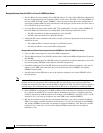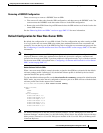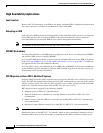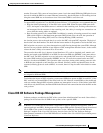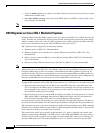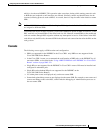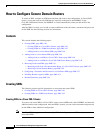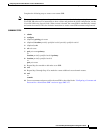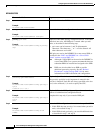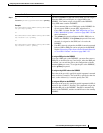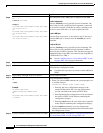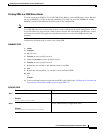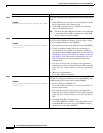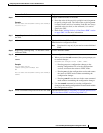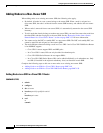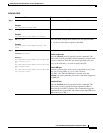
Configuring Secure Domain Routers on Cisco IOS XR Software
How to Configure Secure Domain Routers
SMC-142
Cisco IOS XR System Management Configuration Guide
DETAILED STEPS
Command or Action Purpose
Step 1
admin
Example:
RP/0/RP0/CPU0:router# admin
Enters Administration EXEC mode.
Step 2
configure
Example:
RP/0/RP0/CPU0:router(admin)# configure
Enters Administration configuration mode.
Step 3
pairing pair-name
Example:
RP/0/RP0/CPU0:router(admin-config)# pairing
drp1
(Optional) Enter DRP pairing configuration mode. If the DRP
name does not exist, the DRP pair is created when you add
nodes, as described in the following step.
• pair-name can be between 1 and 32 alphanumeric
characters. The characters '_' or '-' are also allowed. All
other characters are invalid.
DRP pairs are used as the DSDRSC for a non-owner SDR, as
described in the “DSCs and DSDRSCs in a Cisco CRS-1
Router” section on page SMC-132.
Note Although a single DRP can be used as the DSDRSC in
a non-owner SDR, Cisco systems recommends that two
redundant DRPs be installed and assigned to the SDR.
Note DRPs can also be added to an SDR to provide
additional processing capacity. See the “Related
Documents” section on page SMC-164 for more
information on DRP installation and configuration.
Step 4
location partially-qualified-nodeid
partially-qualified-nodeid
Example:
RP/0/RP0/CPU0:router(admin-config-pairing:d
rp1)#
location 0/3/* 0/4/*
(Optional) Specifies the location of the DRPs in a DRP pair.
The partially-qualified-nodeid argument is entered in the
rack/slot/* notation. Node IDs are always specified at the slot
level, so the wildcard (*) is used to specify the CPU.
Step 5
exit
Example:
RP/0/RP0/CPU0:router(admin-config-pairing:d
rp1)#
exit
(Optional) Exits the DRP pairing configuration mode and
returns to Administration configuration mode.
Complete this step only if you created a DRP pair.
Step 6
sdr sdr-name
Example:
RP/0/RP0/CPU0:router(admin-config)# sdr
rname2
Enters the SDR configuration sub-mode for the specified SDR.
• If this SDR does not yet exist, it is created when you add a
node, as described in step 7.
• If this SDR existed previously, you can add additional slots
as described in step 7 and step 8.



